Continuing on in my series of looking at different pastas, this one, another from our “Thick Hand-Rolled Pastas” class. Yes, I know, I’m giving away all the secrets, but believe me, it’s more fun, and you’ll learn more, if you come and take the class with me!
As “money shots” go, I’m not going to claim that that’s the prettiest pasta out there. But then, it’s not supposed to be. Pici, or Pinci, are “poor man’s pasta”, and in general, are supposed to be very basic. And this is probably one of its most traditional presentations, alle briciole, or with breadcrumbs, let alone it’s most basic. Pici originate in the area around Siena, Italy, with the latter name, pinci, being used for the same pasta in the area around Montalcino.
The little inset map shows Siena province (in light green) as compared to all of Tuscany, where it’s located. Siena is also the name of the main city in the province. And you can see Montalcino almost straight south of it. The northern half, more or less, of Siena province is the heart of the Chianti region, as you can see, along with San Gimigniano, another popular wine of the area. Montalcino, of course, is home to the famed Brunello di Montalcino, and you can see over to the east, the area of Montepulciano, where the principle wine is called Vino Nobile di Montepulciano.
But let’s get back to our pasta. First off, plain flour and water only. Maybe a pinch of salt, if you were rich enough to have salt in your kitchen. No semolina, no eggs, nothing fancy. If this is your main course for your dinner, or you’re really hungry, I figure on a cup of flour for two people. If it’s part of a three or more course meal, or you’re watching your carbs, the same amount is sufficient for four. You want a soft, smooth, very pliable dough, that’s not sticky.
Hand rolled out to about a 2mm thickness after resting the dough. As close to a rectangle as you can, it just makes it somewhat easier for the next steps. This is a little thicker than the strozzapreti, from the last post in this series, and because of the way it’s shaped, it doesn’t work to use a pasta rolling machine – unless you want to make really short pici.
On the other hand, the strips are cut narrower, maybe 12-15mm (just over 1/2″). They’re also at least double the length of the strips of dough used for strozzapreti.
Pici, in local dialect, means something to the effect of “pinched”, and the idea here is to first, fold the strips in half and sort of pinch them together at a couple of spots along them, just enough to hold that shape, but not seal it up.
And then you roll it back and forth on the counter to get it to form into a long, thick noodle, with a channel running down it. Some folk just roll these up either on the counter or between their hands, without folding them over first, but I find that too often, all that happens is you end up with a thick noodle without that groove, or channel in it. Then what happens is that when they cook, the water doesn’t get all the way into the center, and you end up with still slightly raw pasta in the core, or it takes ten minutes to cook through to the center, and the outside surface is mushy. It’s worth the extra step to do it right.
Repeat… until they’re all done. Now, many people like to leave them this long – but not everyone does, and although it can be fun to have thick long noodles, sometimes they’re a pain to separate when serving, and also to eat. These are easily 45cm or 18″ long, so…
…depending on my mood, I often cut them in half.
And, toss them into boiling salted water (again, if you’re wealthy enough to afford the salt). They take about 4-5 minutes to cook to al dente.
Meanwhile – probably while the dough is resting after being mixed, and before you roll it out, get together some dry breadcrumbs, garlic, and chili. Rough proportions – for every cup of flour in the dough mix, a half cup of breadcrumbs, 2 cloves of garlic, and 2 small chilies. Some people, if they’re feeling very extravagant, will also add a little chopped parsley to give it some green, but were not going to go all frou-frou on it today. And, of course, if color is important to you, you can use, say, one vivid green and one vivid red chili, just to give more visual interest to the dish.
Just before throwing the pasta in the boiling water, heat up some olive oil – for a half cup of breadcrumbs, I use about a quarter cup of oil. Get it near to smoking hot, and while the pasta is cooking, throw in the garlic and chilies and cook until the garlic just starts to color, it only takes about 30 seconds.
Now, here, like with all Italian recipes, there are three versions for every two Siennese grandmothers out there. The way I learned it was this, where the garlic and chilies are finely chopped and remain in the dish. Others, however, prefer to just crush the garlic cloves and split open the chilies, and saute them in the oil for about 2 minutes until the oil is well flavored with both, and then remove them and continue with just the breadcrumbs. Depends, I suppose, on how much you like garlic and chilies!
Then add the breadcrumbs and continue to cook until they’re golden brown.
Drain the pasta, and then toss it into the hot oil and crumb mixture, and toss to coat well. I usually keep tossing it for about a minute, to just lightly color the pici themselves. If you were adding parsley, this would be your moment. Add a generous pinch of salt as you toss. Because we’re just that rich.
And, we’re back to the finished pasta. Pici alle briciole. Other common ways to serve pici include aglione, or a tomato and garlic sauce; cacio e pepe, with cheese and black pepper; boscaiola, with sauteed wild mushrooms; or, interestingly, going almost a totally different direction, with game meats – duck, boar, hare are among the more common ones, though even here, they tend to be simple sautes with few ingredients rather than a complex ragú. That makes sense from a rustic style perspective. And, somewhere around here I have a recipe for a version made with chicken livers, porcini, and pancetta that’s delicious!
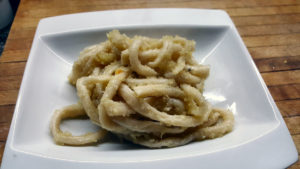
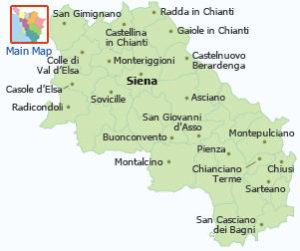
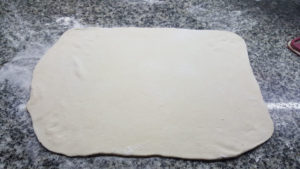
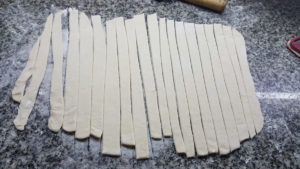
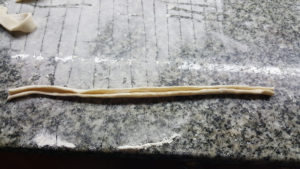
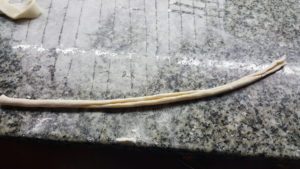
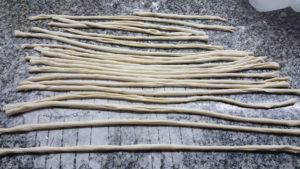
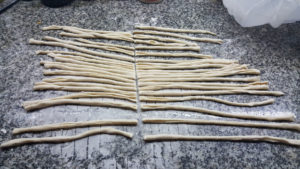
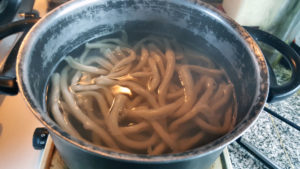
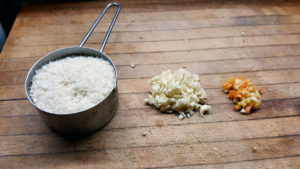
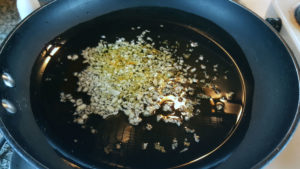
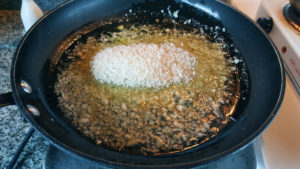
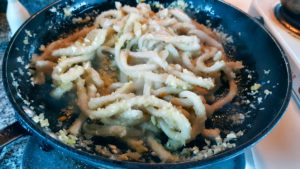
[…] Pici with Broccoli Rape – Handrolled pici; caramelized onions; roasted broccoli rape (one night because of availability, roasted chicory); […]
[…] But at the same time, there are various pastas out there that are coated with toasted breadcrumbs, we’ve even made some in our step-by-step demos here. I will say it’s not my favorite preparation for this pasta, I […]